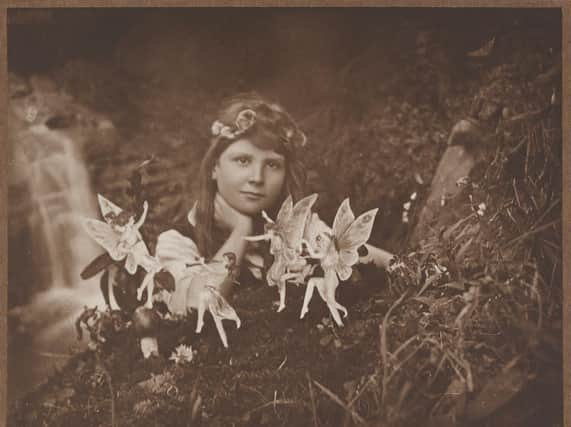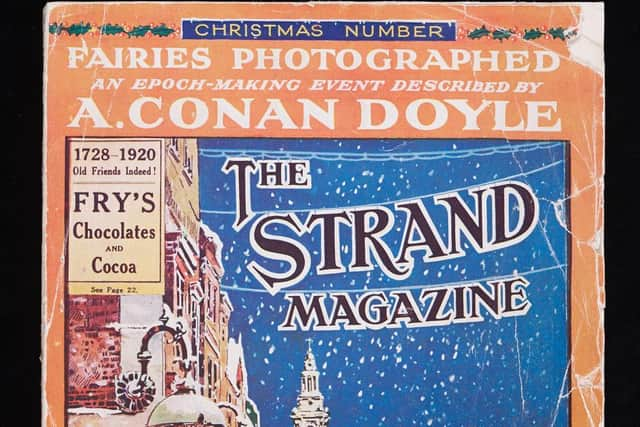How Sherlock Holmes creator Sir Arthur Conan Doyle was fooled by Cottingley fairies hoax


When Sir Arthur Conan Doyle published the infamous Cottingley fairies photographs one hundred years ago this month, he described the images as ‘epoch-making’.
Giving credence to their veracity, he believed their publication in London’s The Strand magazine would mark the dawn of a new era for spiritualism. But it wasn’t to be.
Advertisement
Hide AdAdvertisement
Hide AdIn endorsing the images as genuine, Conan Doyle risked his reputation. The literary genius behind Sherlock Holmes, a character known for his rationality and compulsive determination to seek out the truth, had been inadvertently fooled by one of the biggest hoaxes of the 20th century.


It’s an interesting juxtaposition and one that has captured the fascination of Huddersfield University academic Dr Merrick Burrow.
In an online talk today, to be followed next year by an exhibition featuring documents and artefacts relating to the Cottingley fairies, Dr Burrow will explore just how the creator of the astute detective came to be duped by two girls from Yorkshire.
“One reason the tale continues to draw interest is because of Conan Doyle’s involvement and that mismatch between how people tend to think about the creator of Sherlock Holmes and the idea of validating fairies,” muses the head of English and creative writing. “It seems a bit of a contradiction...
Advertisement
Hide AdAdvertisement
Hide Ad“What interested me about the Cottingley fairies is the sense in which it’s the sort of guilty secret to Conan Doyle studies. It’s the thing that in some sense we would prefer not to talk about because it’s the thing that really damaged his reputation more than anything else.”
Exhibition curator Dr Burrow will tell the tale of how Conan Doyle was drawn in to believe the authenticity of the images, which blew up from a small family prank in July 1917 to become one of the most famous photographic hoaxes of all time.
The story begins in Cottingley near Bradford, where Frances Griffiths, then nine, was living with her cousin 16-year-old Elsie Wright. Frances had been born in South Africa but had moved to England with her parents in Spring 1917.
“She must have felt quite alienated from everything,” Dr Burrow suggests. “She was quite a bit younger than Elsie. They were sharing a bedroom and Elsie befriended her but Frances was spending a lot of time on her own and was hanging around down by the beck in Cottingley.”
Advertisement
Hide AdAdvertisement
Hide AdOne day, Frances returned from the beck with wet shoes, sparking a telling off from her mother. She claimed she had been to see the fairies; Elsie backed her up, telling the adults she’d seen them too and requested to borrow her father’s camera so the girls could ‘prove’ it.
“Elsie was quite a talented artist so she copied some figures of an illustration of fairies in one of Frances’ books, attached them to hat pins and they went and arranged them on the bank and took the most famous photograph of Frances and the fairies,” Dr Burrow says.
Several weeks later the girls borrowed the camera again, and this time returned with a photograph of Elsie sitting on a lawn with a dancing gnome.
“The parents were sceptical [when they saw the images] but the girls stuck to their story...From their point of view it was meant as a bit of a practical joke, as a bit of revenge but it became this point of principle that they wouldn’t confess to how they’d done it. The adults couldn’t explain it but didn’t believe it either.”
Advertisement
Hide AdAdvertisement
Hide AdFor three years, the images were nothing more than a bemusing family puzzle. But in 1920, they found their way to Conan Doyle via a man named Edward L. Gardner of the Theosophical Society.
They had come to his attention after one of the girls' mothers took the images to a society talk on ‘fairy life’,, held in Bradford. He began using them in lectures about fairies and elemental beings that he was giving in London. “Once it was in those London occult and spiritualist circles, it got to Conan Doyle’s attention,” Dr Burrow explains. “Things snowballed.”
Conan Doyle had been interested in spiritualism for a number of years and in 1917, devoted himself to promoting its cause. “He was looking for an opportunity to try to prove his case beyond doubt, that spirits really existed and it could be proved...I think he just looked at these photos and thought well how could these girls in rural North of England produce these photographs.
“They had been verified by an independent photographer as not being double exposures or some sophisticated studio work, which of course they weren’t.
Advertisement
Hide AdAdvertisement
Hide Ad“But Conan Doyle at that point was really believing what he wanted to believe. He saw this as his opportunity to send a salvo against his enemies in the anti-spiritualist community so that’s what he did. I think he was being quite careless with his reputation by that point.”
In December 1920, he published the images in The Strand. Gardner and Conan Doyle also corresponded with the girls, giving them books, letters and new cameras and asking them to take more images, for further publication. “There were all these inducements being offered to the girls and they were caught in a bit of a trap they couldn’t really get out of,” Dr Burrow says.
“The public response to the fairy photographs was a mixture of fascination and bemusement and there was large scale ridicule of Conan Doyle and this sense in which he’d been taken in by what a lot of people considered to be a fairly obvious hoax. But the girls wouldn’t admit it.”
They had made a pact to never confess to how they’d taken the photos – and by now, felt they couldn’t without humiliating both Conan Doyle and Gardner. It wasn’t until the mid-1980s, years after both men had died, that Elsie wrote a letter of confession and the story unfolded.
Advertisement
Hide AdAdvertisement
Hide AdThe University of Leeds Special Collections at the Brotherton Library holds nearly all of the most important documents and artefacts relating to the hoax. This is the first time an exhibition has been curated using the material, including the fairy images, The Strand article, and correspondence between Conan Doyle and Gardner, as well as one of the cameras gifted to Elsie and Frances by Conan Doyle, which is being borrowed from the National Science and Media Museum in Bradford.
The collection, Dr Burrow says, “illuminates in the most fascinating detail how Conan Doyle’s tentative interest developed into an unshakable, but mistaken, confidence in the authenticity of the images”.
“I think it has all sorts of interesting resonances with today in terms of our present concerns about social media bubbles and how people end up believing things and become incredibly entrenched because they’re talking to people who believe the same things as them. That’s kind of what happened with Conan Doyle.”
Speculating why there’s still interest today in the Cottingley fairies ‘accidental conspiracy’, Dr Merrick Burrow says: ”I think there’s the delight we all secretly must feel about the idea that a couple of girls with no expertise or photographic experience managing to pull off this hoax, even if they didn’t intend to do it. Also, the idea that you would be able to produce photographic evidence of fairies is such an outrageous proposition in the first place.”
Advertisement
Hide AdAdvertisement
Hide AdToday’s talk will mark the centenary of Conan Doyle’s publication of the images. The exhibition, The Cottingley Fairies: A Study in Deception, will be on display in the Treasures of the Brotherton Gallery in Leeds in 2021. Visit library.leeds.ac.uk/galleries
Support The Yorkshire Post and become a subscriber today. Your subscription will help us to continue to bring quality news to the people of Yorkshire. In return, you'll see fewer ads on site, get free access to our app and receive exclusive members-only offers. Click here to subscribe.